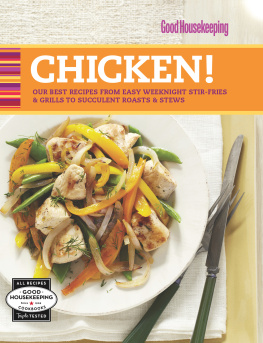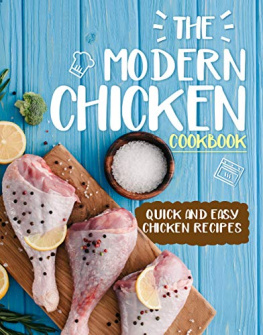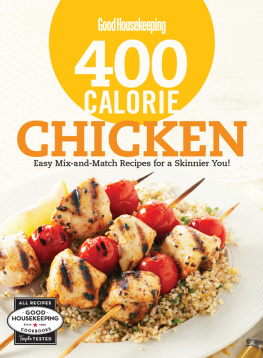Good Housekeeping
CHICKEN!
OUR BEST RECIPES FROM EASY WEEKNIGHT STIR-FRIES & GRILLS TO SUCCULENT ROASTS & STEWS
HEARST BOOKS
New York
HEARST BOOKS
New York
An Imprint of Sterling Publishing
387 Park Avenue South
New York, NY 10016
Good Housekeeping is a registered trademark of Hearst Communications, Inc.
Hearst Books is a trademark owned by Hearst Communications, Inc.
2012 by Hearst Communications, Inc.
Portions of this book were previously published under the title Good Housekeeping 100 Best Chicken Recipes.
All rights reserved. No part of this publication may be reproduced, stored in a retrieval system, or transmitted, in any form or by any means, electronic, mechanical, photocopying, recording, or otherwise, without prior written permission from the publisher.
ISBN 978-1-58816-940-2
GOOD HOUSEKEEPING
Rosemary Ellis
EDITOR IN CHIEF
Courtney Murphy
CREATIVE DIRECTOR
Susan Westmoreland
FOOD DIRECTOR
Samantha B. Cassetty, M.S., R.D.
NUTRITION DIRECTOR
Sharon Franke
KITCHEN APPLIANCES AND FOOD
TECHNOLOGY DIRECTOR
BOOK DESIGN: Memo Productions
PROJECT EDITOR: Sarah Scheffel
Photography Credits

The Good Housekeeping Cookbook Seal guarantees that the recipes in this cookbook meet the strict standards of the Good Housekeeping Research Institute. The Institute has been a source of reliable information and a consumer advocate since 1900, and established its seal of approval in 1909. Every recipe has been triple-tested for ease, reliability, and great taste.
For information about custom editions, special sales, and premium and corporate purchases, please contact Sterling Special Sales at 800-805-5489 or specialsales@sterlingpublishing.com.
2 4 6 8 10 9 7 5 3 1
www.sterlingpublishing.com

Like many family cooks, you may already be preparing chicken a couple of nights a week and looking for new inspiration. With annual chicken consumption at 83 pounds per person, new chicken recipes are in high demand. Welcome to Good Housekeeping Chicken! In this book weve collected dozens of delicious triple-tested recipes, from our chicken-in-a-flash stir-fries and grills and easy-to-throw-together salads and sandwiches to long-simmering soups and stews and soul-satisfying casseroles and roasts.
For nights when you need to get dinner on the table in under half an hour, turn to the chapter on stir-fries and sauts. Try Plum Balsamic Chicken, ready in 30 minutes with the help of a bit of honey and a splash of balsamic vinegar. If your familys tastes run to Asian, whip up the Peanut Chicken Stir-Fryits teen-approved in my house. And dont forget to check out our slow-cooker recipes; these allow you to toss some simple ingredients in the pot in the morning and serve up a comforting soup or stew minutes after you walk in the door in the evening.
Youll also find a variety of roast chickens, from a simple version with lemon and rosemary to a meal in a pan: roasted parts with root vegetables. Chicken provides a succulent canvas for just about any mix of ethnic flavors, herbs, and spices. Whether you want to stir-fry chicken tenders, braise bone-in thighs, or saut breast cutlets, youll find these cuts are in the meat case. And, natural, organic, local, and free-range options are more readily available than ever before. All this and a great nutrition profile, tooits no wonder that chicken has become the most frequently served main dish on American dinner tables.
Be sure to check out the icons following the nutritional information in each of our recipes: Low-cal and heart-healthy recipes keep dinnertime healthy, while ready-in-thirty-minutes, make-ahead, and slow-cooker options help make it stress-free for the cook!
SUSAN WESTMORELAND
Food Director, Good Housekeeping
Chicken is featured in most cuisines of the world. Prized for its ability to adapt to many flavors and cooking methods, its a favorite for stews, barbecues, gumbos, stir-fries, and holiday roasts.
Know Your Chicken
The United States Department of Agriculture inspection sticker on poultry guarantees that is was raised and processed according to government guidelines. Grade A birds, the most common variety in supermarkets, are the highest quality. And more than 90 percent of all broiler-fryers (see below) are marketed under a brand name, a further assurance of quality. Select a bird thats appropriate to the recipe and cooking technique youve chosen. For an overview of additional options on the market, from organic to free-range to kosher, see .
Broiler-fryers: Tender young birds that weigh 2 to 5 pounds. They can be roasted, fried, sauted, grilled, or broiled.
Roasters: Meaty birds that usually weigh 5 to 8 pounds. They are best when roasted.
Cornish hens: Small birds that weigh up to 2 pounds each. They are tasty grilled, broiled, and roasted.
Fowl: Also called stewing hens, these tough, older birds are available especially around the holidays. They are always braised or stewed and make the tastiest chicken broth.
Capons: Neutered male chickens that weigh 8 to 10 pounds on average. They are very meaty and tender and are usually roasted.
Buying Fresh and Frozen Chicken
Follow these guidelines when selecting poultry.
Fresh chicken meat, whether whole birds or parts, should appear plump. The breast should be meaty. All skin should be smooth and moist and free of bruises and pinfeathers; the skin color can range from creamy white to yellow, depending on the birds feed and breed.
Inspect the package carefully before you buy fresh chicken. Check the sell-by date, and avoid packages with leaks and tears.
Be alert to the way fresh chicken smells. When you first open the package, there may be a slight odor. This is caused by oxidation and should disappear quickly. If the poultry still smells after a couple of minutes, return it to the market.
Frozen chicken should be rock hard and show no signs of freezer burn. The packaging should be tightly sealed and intact. Frozen liquid puddled in the bottom of the package or the presence of ice crystals can indicate that the bird was thawed and refrozen.
CHICKEN SHOPPING CHOICES
If you are looking for a good-quality bird for your dinner table, you have more options than ever.
Organic: Chicken bearing the label organic has been raised on organically grown feed that is free of antibiotics and hormones. The USDA conducts inspections to enforce these standards for organic chickens.
Free-range: These birds have been raised in an environment that provides access to open spaces, though not necessarily an open farmyard and not always for the life of the bird. Although practices vary, the freer range of movement allows the birds to develop more muscle, which contributes to a leaner, fuller-flavored meat.
All-natural: This simply means that the chicken has been minimally processed and doesnt contain artificial ingredients like preservatives. Its feed was not necessarily organic and might have contained antibiotics.
Kosher: Kosher birds have been processed according to Kosher dietary laws under the strict supervision of a rabbi. The procedure includes salting to draw out the blood and season the meat.
Next page












